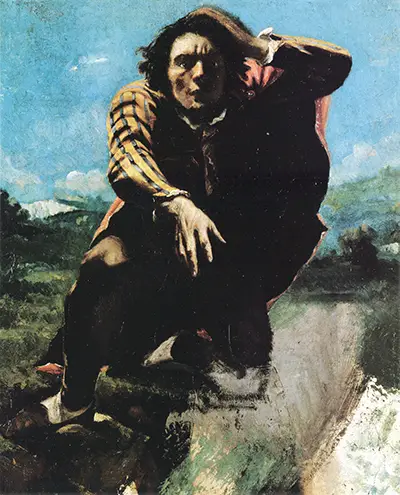The Man Made Mad by Fear by Gustave Courbet (1819-1877) is an oil on canvas painted in 1843 - 45. The early paintings by Courbet include portraits of his family, such as his 1841 Juliette Courbet at the Age of Ten, which features his younger sister and paintings inspired by literary themes.
The Man Made Mad by Fear is one of several paintings reflecting a new direction for the artist as he moved into self-portraits. The self-portraits of Courbet are an eclectic mixture. The 1844 Self-Portrait with a Black Dog, for example, is very different from The Man Made Mad by Fear. Self-Portrait with a Black Dog is a more conservative picture, showing himself as poised and elegant with his fashionable black, English spaniel. It provides a stark contrast to the desperate pose and panicked expression of The Man Made Mad by Fear. Yet there are some similarities. Both show him as well dressed in gaudy, dandified clothing. Another common feature is the background, as both include a country setting - the chalky cliffs and rolling hills of his native Ornans.
Gustave Courbet had been born in Ornans in 1819 into a prosperous, but provincial family. He had moved to Paris in 1839, just a few years before he painted The Man Made Mad by Fear. Initially, he had worked at the studio of Steuben and Hesse, but this traditional set-up had not suited him and he left, preferring to study the old masters in the Louvre with artists such as José de Ribera, Velasquez, Zurbaran, and Rembrandt particularly influencing his work. The self-portraits of this period seem to reflect the emotions of Courbet as a provincial seeking his own place and style. So while many of his self-portraits show a confident young man, The Man Made Mad by Fear reflects very different emotions as the young artist prepares for his leap into the unknown, reaching out, yet afraid of what the future might hold.
The Man Made Mad by Fear displays the most extreme emotion of Courbet's self-portraits and was even once exhibited under the name The Suicide. It has been left unfinished in the lower section, giving it a sketch-like appearance and includes a curious detail of a hand-print in the lower right-hand corner. However afraid Courbet may have been as he painted, the bold mix of colours demonstrate how he has already found his own voice in the art world and the confidence to flout convention, helping to build his reputation as one of the most exciting painters of the nineteenth century. It is currently housed at the National Museum of Art, Architecture and Design in Norway.




